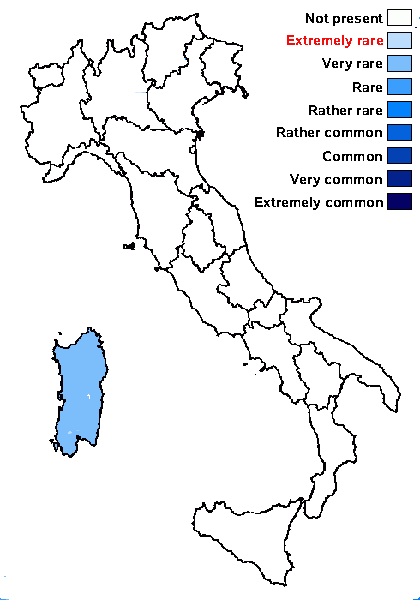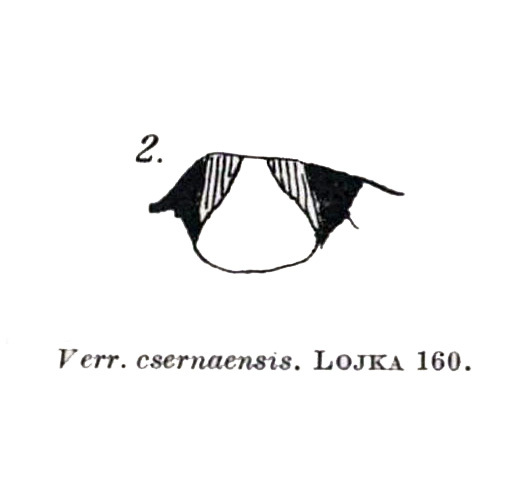Verrucaria cernaensis Zschacke
Hedwigia, 67: 50, 1927
Synonyms:
Distribution: C - Sar (Nascimbene & al. 2023).
Description: Thallus crustose, episubstratic, well-developed, 100-300 μm thick or more, not gelatinous when wet, grey-brown to dark brown, strongly rimose, often also with discrete areoles. Cortex with a brown pigment; lower part of medulla often with areas of brown pigment, but without a black basal layer. Perithecia black, 2/3 to completely immersed in thallus, or forming low to moderate, 0.12-0.36 mm wide projections. Involucrellum well-developed, sometimes mainly apical, but often reaching to base-level, more or less appressed to exciple, the sides steeply conical or even vertical; exciple 0.22-0.32 mm across, the wall dark brown, K+ darker brown or greyish brown; hamathecium of periphyses and periphysoids, interascal filaments absent; hymenial gel hemiamyloid, I+ red (I+ blue at very low concentrations of I), K/I+ blue. Asci 8-spored, clavate, I-, fissitunicate, the wall thickened above, with an ocular chamber, dehiscent by extrusion of an endotunica to form a delicate rostrum, Verrucaria-type. Ascospores 1-celled, hyaline, ellipsoid, (15-)18-22(-27) x (7.5-)9.5-11.5(-14) μm, (1.5-)1.7-2.1(-2.4) times as long as wide, without a perispore. Pycnidia frequent, scattered, 40-60 μm wide. Conidia straight or slightly curved, 4-8 x c. 1 μm. Photobiont chlorococcoid, the cells usually arranged in vertical columns. Spot tests: K-, C-, KC-, P-, UV-. Chemistry: without lichen substances.
Note: on frequently submerged siliceous or calciferous rocks beside lakes and rivers, and on seeping rocks. a species described from the Carpathians, often considered as a synonym of V. aethiobola. According to Thüs (see Nimis 2016) the epithet aethiobola was used for two genetically well-separated taxa: V. aethiobola s.str. and V. cernaensis, and it is likely that at least some of the lowland records from the Alps could refer to the latter species.
Growth form: Crustose
Substrata: rocks
Photobiont: green algae other than Trentepohlia
Reproductive strategy: mainly sexual
Periodically submerged (e.g. in creeks)
Commonnes-rarity: (info)
Alpine belt: absent
Subalpine belt: absent
Oromediterranean belt: absent
Montane belt: very rare
Submediterranean belt: very rare
Padanian area: absent
Humid submediterranean belt: very rare
Humid mediterranean belt: very rare
Dry mediterranean belt: very rare

Predictive model
Growth form: Crustose
Substrata: rocks
Photobiont: green algae other than Trentepohlia
Reproductive strategy: mainly sexual
Periodically submerged (e.g. in creeks)
Commonnes-rarity: (info)
Alpine belt: absent
Subalpine belt: absent
Oromediterranean belt: absent
Montane belt: very rare
Submediterranean belt: very rare
Padanian area: absent
Humid submediterranean belt: very rare
Humid mediterranean belt: very rare
Dry mediterranean belt: very rare

Predictive model
 INDEX FUNGORUM
INDEX FUNGORUM
 GBIF
GBIF


